The Wonders of Black Seed
Dr. Claire Arcidiacono, ND
I am very excited to start this conversation on black seed. Black Seed is an amazing nutrient for our respiratory system. Invite health has a unique formula which includes Black Seed, Cordyceps and Rosemary Extract. Each of these nutrients are helpful in promoting respiratory health. Let’s go through each component of Black Seed, shall we?
Let’s start with Black Seed. What exactly is black seed? Well black seed is also known as black cumin, Nigella or Nigella Sativa. It is a flowering plant that can be used for its medicinal properties. (1) Black Seed has been found to contain antioxidant qualities. (2) In 2011 a study found that using Black Seed for approximately 2 weeks reduced nasal symptoms such as nasal congestion, itchy nose, runny nose and even sneezing. (3) A more recent study in 2018 found that Black Seed can even help to reduce the symptoms of sinusitis. This study found that Black Seed can help to reduce histamine (the bad guy when it comes to a lot of allergy symptoms). Black Seed has also been found to be antimicrobial which means it can also help protect our respiratory tract form pathogens or bad guys). (4) Studies have also found that Black Seed may be helpful in lowering inflammation and can help increase asthma control. (5) Studies have found that the anti-inflammatory and anti- allergic effects of Black Seed can help reduce the symptoms of allergic rhinitis. (6) Other studies have found Black Seed to be an effective treatment for allergic rhinitis. (7) Black Seed has also been found to help with lung function in those with COPD. (8) Studies have found that Black Seed can help with allergies, obstructive lung disease and other types of respiratory disease. (9)
Moving on from black seed the next item is Rosemary. Rosemary is much more than just a yummy spice to put on chicken. Studies have found that Rosemary can help to protect against lung fibrosis. (10) Studies have also found that Rosemary can help with treatment resistant asthma. (11) Studies have found that Rosemary has potential to be protective against viral infections such as COVID-19. (12) Rosemary has also been found to help reduce the symptoms of COPD. (13) According to WEBMD Rosemary has been found to be very powerfully antibacterial, antiviral and even antifungal. Thus Rosemary is able to help our body to fight off infections. (14) Overall Rosemary is an amazing part of Invite’s Black Seed formula.
The last nutrient that is in the Black Seed formula is Cordyceps. If you are wondering what exactly is Cordyceps don’t worry! I’ll be getting into that right now. Cordyceps are a type of medicinal fungus or in other words it is a type of mushroom. It grows on worms rather than on trees which is what you might have been expecting! (15) Studies have found that Cordyceps can help with our overall lung health and can even help with conditions such as lung fibrosis. (16) Other studies have found that using Cordyceps can also help with reducing the symptoms of COPD. (17) Studies have found that Cordyceps can help with fighting pathogens since it has been found to be antiviral and can even help boost our immune system. (18)
Overall Invite health really has a winner with its Black Seed formula. The nutrients found in Black Seed have all been found to help with so many different aspects of the respiratory tract. In addition to helping with our respiratory tract the ingredients in Black Seed have been studies to help with other aspects of our health. Now I know a lot of people are probably thinking but why can’t I just eat mushrooms or sprinkle some Rosemary on my food? It’s all about the therapeutic dose. While it’s fine to have a few mushrooms sautéed and added to our food unfortunately it’s not enough to get the full benefits of them. The same is true for the Black Seed and Rosemary. Adding in Invite’s Black Seed with Rosemary and Cordyceps formula is an amazing way to ensure you get a therapeutic dose and truly benefit from these nutrients.
Our next blog will be something that will be approaching us soon! And that is Seasonal allergies!
Sources:
- https://www.healthline.com/nutrition/kalonji-nigella-seeds
- https://www.verywellhealth.com/health-benefits-of-black-seed-oil-89421
- https://www.sciencedirect.com/science/article/abs/pii/S0196070910001407
- https://www.sciencedirect.com/science/article/pii/S2213422017302214
- https://www.ncbi.nlm.nih.gov/pmc/articles/PMC6111118/
- https://www.sciencedirect.com/science/article/pii/S1808869422001185
- https://pubmed.ncbi.nlm.nih.gov/23855426/
- https://www.ncbi.nlm.nih.gov/pmc/articles/PMC7452452/
- https://www.ncbi.nlm.nih.gov/pmc/articles/PMC6526035/
- https://www.ncbi.nlm.nih.gov/pmc/articles/PMC6130597/
- https://erj.ersjournals.com/content/42/Suppl_57/P737
- https://content.iospress.com/articles/mediterranean-journal-of-nutrition-and-metabolism/mnm210013
- https://www.sciencedirect.com/science/article/abs/pii/S1550830723002288
- https://www.webmd.com/diet/health-benefits-rosemary
- https://www.researchgate.net/publication/8138660_The_traditional_Chinese_medicine_Cordyceps_sinensis_and_its_effect_in_apoptotic_homeostasis
- https://www.ncbi.nlm.nih.gov/pmc/articles/PMC7125542/
- https://www.hindawi.com/journals/ecam/2019/4903671/
- https://www.ncbi.nlm.nih.gov/pmc/articles/PMC7898063/







